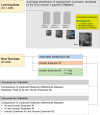Automated identification of cephalometric landmarks: Part 2-Might it be better than human?
- PMID: 31335162
- PMCID: PMC8087057
- DOI: 10.2319/022019-129.1
Automated identification of cephalometric landmarks: Part 2-Might it be better than human?
Abstract
Objectives: To compare detection patterns of 80 cephalometric landmarks identified by an automated identification system (AI) based on a recently proposed deep-learning method, the You-Only-Look-Once version 3 (YOLOv3), with those identified by human examiners.
Materials and methods: The YOLOv3 algorithm was implemented with custom modifications and trained on 1028 cephalograms. A total of 80 landmarks comprising two vertical reference points and 46 hard tissue and 32 soft tissue landmarks were identified. On the 283 test images, the same 80 landmarks were identified by AI and human examiners twice. Statistical analyses were conducted to detect whether any significant differences between AI and human examiners existed. Influence of image factors on those differences was also investigated.
Results: Upon repeated trials, AI always detected identical positions on each landmark, while the human intraexaminer variability of repeated manual detections demonstrated a detection error of 0.97 ± 1.03 mm. The mean detection error between AI and human was 1.46 ± 2.97 mm. The mean difference between human examiners was 1.50 ± 1.48 mm. In general, comparisons in the detection errors between AI and human examiners were less than 0.9 mm, which did not seem to be clinically significant.
Conclusions: AI showed as accurate an identification of cephalometric landmarks as did human examiners. AI might be a viable option for repeatedly identifying multiple cephalometric landmarks.
Keywords: Artificial intelligence; Automated identification; Cephalometric landmarks; Deep learning; Machine learning.
Conflict of interest statement
The final form of the machine learning system was developed by DDH Inc (Seoul, Korea), which is expected to own the patent in the future. Among the coauthors, Hansuk Kim and Soo-Bok Her are shareholders of DDH Inc. Youngsung Yu and Girish Srinivasan are employees there. Other authors do not have a conflict of interest.
Figures



Similar articles
-
Automated identification of cephalometric landmarks: Part 1-Comparisons between the latest deep-learning methods YOLOV3 and SSD.Angle Orthod. 2019 Nov;89(6):903-909. doi: 10.2319/022019-127.1. Epub 2019 Jul 8. Angle Orthod. 2019. PMID: 31282738 Free PMC article.
-
Evaluation of automated cephalometric analysis based on the latest deep learning method.Angle Orthod. 2021 May 1;91(3):329-335. doi: 10.2319/021220-100.1. Angle Orthod. 2021. PMID: 33434275 Free PMC article.
-
Automatic identification of posteroanterior cephalometric landmarks using a novel deep learning algorithm: a comparative study with human experts.Sci Rep. 2023 Sep 19;13(1):15506. doi: 10.1038/s41598-023-42870-z. Sci Rep. 2023. PMID: 37726392 Free PMC article.
-
Can artificial intelligence-driven cephalometric analysis replace manual tracing? A systematic review and meta-analysis.Eur J Orthod. 2024 Aug 1;46(4):cjae029. doi: 10.1093/ejo/cjae029. Eur J Orthod. 2024. PMID: 38895901 Free PMC article.
-
Automatic cephalometric landmark identification with artificial intelligence: An umbrella review of systematic reviews.J Dent. 2024 Jul;146:105056. doi: 10.1016/j.jdent.2024.105056. Epub 2024 May 8. J Dent. 2024. PMID: 38729291
Cited by
-
[Current Status and Analysis of the Clinical Application of Digital Technology in Oral Medicine].Sichuan Da Xue Xue Bao Yi Xue Ban. 2024 Jan 20;55(1):101-110. doi: 10.12182/20240160301. Sichuan Da Xue Xue Bao Yi Xue Ban. 2024. PMID: 38322515 Free PMC article. Chinese.
-
Development, Application, and Performance of Artificial Intelligence in Cephalometric Landmark Identification and Diagnosis: A Systematic Review.Healthcare (Basel). 2022 Dec 5;10(12):2454. doi: 10.3390/healthcare10122454. Healthcare (Basel). 2022. PMID: 36553978 Free PMC article. Review.
-
The Accuracy of Algorithms Used by Artificial Intelligence in Cephalometric Points Detection: A Systematic Review.Bioengineering (Basel). 2024 Dec 18;11(12):1286. doi: 10.3390/bioengineering11121286. Bioengineering (Basel). 2024. PMID: 39768104 Free PMC article. Review.
-
Comparing intra-observer variation and external variations of a fully automated cephalometric analysis with a cascade convolutional neural net.Sci Rep. 2021 Apr 12;11(1):7925. doi: 10.1038/s41598-021-87261-4. Sci Rep. 2021. PMID: 33846506 Free PMC article.
-
A rapid identification method for soft tissue markers of dentofacial deformities based on heatmap regression.BDJ Open. 2024 Mar 1;10(1):14. doi: 10.1038/s41405-024-00189-5. BDJ Open. 2024. PMID: 38429260 Free PMC article.
References
-
- Redmon J, Farhadi A. Yolov3: an incremental improvement. arXiv preprint arXiv180402767. 2018 Available at: https://arxiv.org/pdf/1804.02767.pdf.
-
- Redmon J, Divvala S, Girshick R, Farhadi A. You Only Look Once Unified RealTime Object Detection. 2016 IEEE Conference on Computer Vision and Pattern Recognition (CVPR); 2016. pp. 779–788.
-
- Wang CW, Huang CT, Hsieh MC, et al. Evaluation and comparison of anatomical landmark detection methods for cephalometric x-ray images: a grand challenge. IEEE Trans Med Imaging. 2015;34:1890–1900. - PubMed
Publication types
MeSH terms
LinkOut - more resources
Full Text Sources

